The Asus Chromebook C300 is based around an Intel Bay Trail-M processor, with dual- and quad-core options available. Our sample came with the lesser dual-core Celeron N2830 option. This runs at 2.16GHz, and doesn't support Hyper-Threading so only offers two physical cores.
But it still has features like support for virtualisation, and a Turbo Boost mode that allows it to ramp up to 2.41GHz when required. The specification can't match the Core series, but the N2830 only draws a maximum of 7.5W, and typically more like 6W, so should provide excellent battery life, compared to even the most miserly 11.5W mobile Intel Core i3.
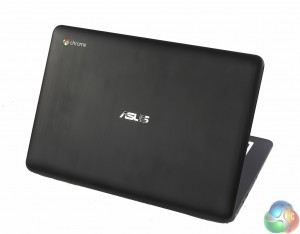
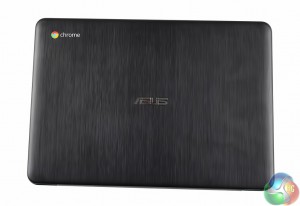
The system supports up to 4GB of 1,333MHz DDR3L SDRAM, but our sample only had 2GB, which would have been an issue for a Windows laptop or MacBook, but should be fine for Chrome OS's more modest requirements. The Bay Trail-M range is a “System on a Chip” (SoC), so includes graphics as well.
This comes in the form of Intel HD graphics with four execution units running at 313MHz, or 750MHz in Turbo mode. This won't be anywhere near as capable as the latest Intel HD Graphics 4000 chipsets, but it does at least support DirectX 11, OpenGL 4.0 and OpenCL 1.1, even if none of this is that relevant on a Chromebook.
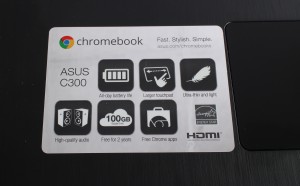
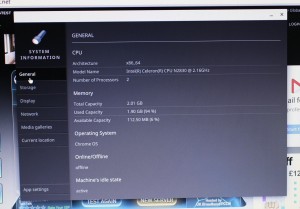
There are two storage options – 16GB or 32GB eMMC. Our sample came with the larger quantity, but this is augmented by 100GB of Google Drive online storage, free for two years. If you happen to have an educational Google account, you will be able to enjoy 1TB of online storage, which should be enough for most needs.
Google was also offering this to all Chromebook purchasers at the time of writing, although the offer expires on 1st January 2015. You could also use the SD card reader to add local storage if required.
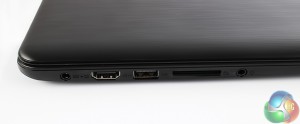
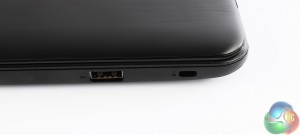
Alongside the SD card slot on the left, the C300 sports a combined headphone and microphone minijack, a USB 3.0 port, and full-sized HDMI. The right is home to a USB 2.0 port and Kensington lock slot. This is just about adequate for a 13in notebook, although some models have Gigabit Ethernet as well.
There's 802.11a/b/g/n WiFi (some models also add 802.11ac) and Bluetooth 4.0, but no mobile data on our sample, although here again it is an option on some models.
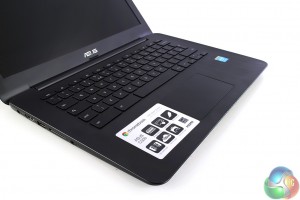
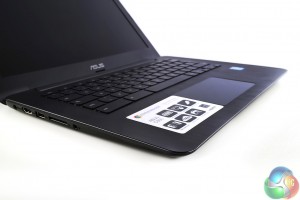
The Asus Chromebook C300's 13.3in screen is reasonable for such a cheap notebook, but nothing too exciting. It only offers a 1,366 x 768 resolution, which is starting to look low for this screen size. The matt finish means there are no problems with unwanted reflections, although viewing angles are merely decent. The Chiclet-style keyboard offers comfortably-sized keys.
We found the action a little shallow and soft for really comfortable typing, but there is a recognisable “click”, so touch typists should find it reasonably easy to get along with. The large trackpad is positioned centrally, rather than directly beneath the space bar, but in practice we had no issues with accidentally brushing it whilst typing. It's accurate and the button action extends across the entire pad.
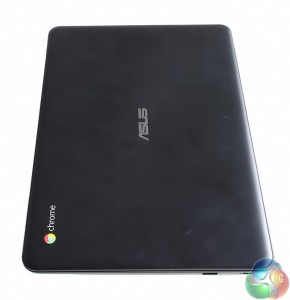
Of course, Chromebooks are only partially about the hardware. In fact, they can be seen more as a convenient (and cheap) way to get to your Google services and apps. Once you have signed in with your Google ID, or created a new one, pretty much everything is set up for you already.
Icons on the taskbar at the bottom will take you straight to your Google Docs and Gmail, whilst an icon in the same place as the Windows Start button guides you to access to the other standard apps, which you can extend through the Web Store.
Most of these require a working Internet connection to function, but you can configure the main Docs apps to operate offline, as well as cache your documents to the local storage, so you can edit them whether or not you are connected. Nevertheless, you do lose a lot of functionality without an Internet connection.
 KitGuru KitGuru.net – Tech News | Hardware News | Hardware Reviews | IOS | Mobile | Gaming | Graphics Cards
KitGuru KitGuru.net – Tech News | Hardware News | Hardware Reviews | IOS | Mobile | Gaming | Graphics Cards


